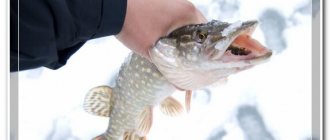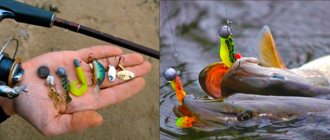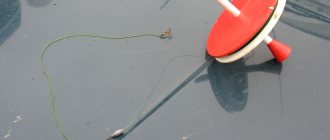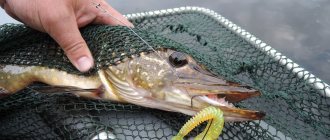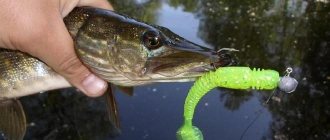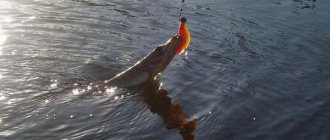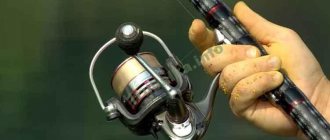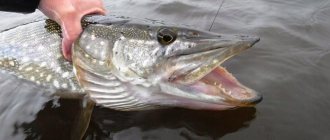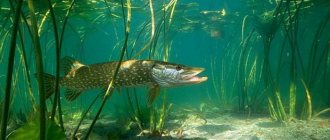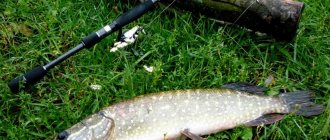Catching pike with a jig stands apart from other spinning methods. This business has its own philosophy and thrill, its own rules and its own pitfalls. You can catch pike with jig baits almost all year round and in almost any conditions - fortunately, the choice of models, installation options and methods of rubber/foam rubber animation is huge and allows you to cover all the fishing and fish “wants”.
Aqua Relax seduced...greedy grasp
Gin is especially effective at great depths, where even divers’ wobblers and heavy jigs cannot reach. There are several other advantages, including the following:
When and why is jig good: advantages
- Variety of baits and mounting options. Sizes from 1 inch to 5 or more allow you to seduce any pike from a 100 gram cord on a micro jig, to a ten-gram “mother” on a huge ripper or worm. Various colors allow you to fish at any time of the year and at any depth. Various equipment and types of installation allow you to fish even the most difficult bottom topography - among snags and stones, mully bottom and others. Spaced rigs are more catchy than a regular rig on a jig head in some cases.
For example, this type of installation holds a vibrating tail well and detects a predator, but is not suitable for a snag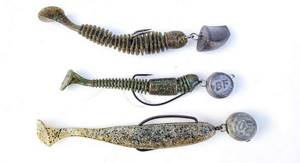
Hinged mounting on an eared sinker - and this one is just for strong places - Versatility . It follows from the previous fact. It is possible to catch pike with a jig all year round - in spring, summer and especially effectively in the fall before freeze-up and in almost all conditions.
- Edibility as an additional tempting factor. Neither wobblers nor spinners can boast of such quality. It is edibility that allows you to seduce the most passive fish and get away from zero.
- Possibility of fishing at great depths and large water areas . Jigs with powerful gear and heavy loads allow you to catch the most inaccessible pike sites - channel edges, pits, bays, and reservoirs. Moreover, this can be done much faster than with wobblers or spinners.
- Quick change of wiring depth . There is no need to change the rubber bait, just change the Cheburashka weight and the bait will go a meter or several deeper/shallower.
- Relative cheapness and availability . Silicone baits cost much less than wobblers and iron spinners and spinners. This means you can assemble a set with wide possibilities for all fishing occasions. And you can also not be afraid to tear off the bait and fish the most promising places, which are often the most snagged.
Jig heads and baits
bright jig head Fire
The choice of jig head depends on the fishing conditions and the bait that is used to attract the predator.
In the case when artificial silicone bait is used, then for catching pike perch you should choose bright colors; the fish may be most interested in orange and lemon colors. The size of the bait, even when hunting trophy pike perch, should not exceed 12 centimeters. The weight of the bait depends on many factors, but the average weight is in the range of 15 - 18 grams.
Features of catching pike with jig baits depending on the season
The peculiarities of jig fishing differ greatly depending on the season - in spring, summer and autumn, pike prefers different sites, different baits, equipment and options for their animation.
Catching pike with a jig in spring
Before spawning, the pike walks around the reservoir with eggs in search of a place to spawn, it is sluggish and has no time for food, its belly is filled with future offspring - the toothed predator often ignores large rubber. Give her something smaller and slower.
In the spring after spawning, the predator is still sick after spawning and is not yet ready to hunt for large baits. It is worth trying at this time to catch pike with small worm-shaped baits, for example, Javastik from Imakatsu, Crazy Fish Polaris, Reins Aji Ringer, Bait Breath Needle, Tsunekichi Worm and others in the size of 1-2 inches. And also for small rippers in the same size - Pontoon 21 Awaruna, Keitech Swing Impact, classics - Hoof from Relax and Predator o Mance, as well as others.
Interestingly, unlike in autumn, in spring pike prefers slow wave-like movements, without sudden movements. Dragging along the bottom and near the bottom, a light lazy step. Spring people should take this into account.
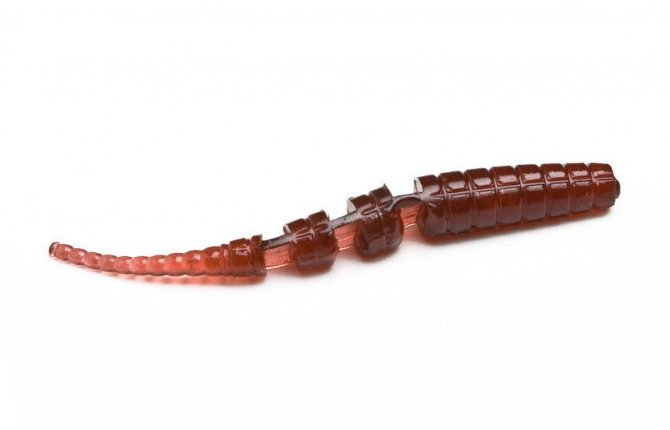
After spawning, pike migrate slowly throughout the reservoir in search of easy money. Tired and still lethargic, she follows the path of least resistance - looking for places for an ambush with the least current. Pits near steep banks, places behind sharp turns in the current, in snags and behind boulders, she likes whirlpools and flood lakes. Often, having entered an oxbow lake to spawn, she remains there with her babies (feeding on them as they go).
The fact that pike is in constant motion after spawning prompts the idea that it needs to be searched throughout the entire water area, exploring the entire fishing sector with fan casts and not staying too long in one place, constantly looking for new fishing spots.
You should carefully observe the surface of the water. Often the toothy beauty reveals itself with splashes and a scattering of silvery fry.
In the spring, inactive animation options are used. A slow step, pulling along the bottom and in the water column with the help of a rod, actively playing jigs show themselves well on a regular basis.
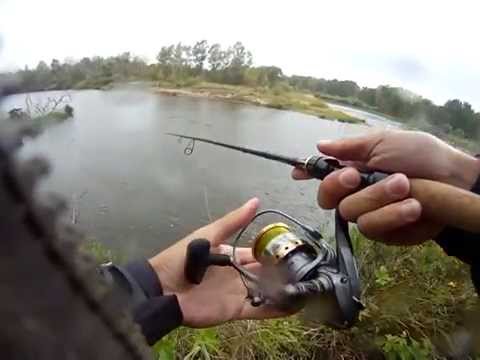
Behind the island there is a slow current, such points should not be missed
Migration of pike in the water column and throughout the reservoir is observed until the end of April-mid-May, until the water warms up, then it gradually begins to migrate to its usual summer camps. In particular, small grass begins to flourish on heated shallows and areas near them.
Summer fishing with silicone baits
In summer the water warms up. June-July is one of the most difficult months in terms of trophies. Summer pike is best caught at dawn. Weather factors have a great influence on its activity. Rain, breeze, coolness, fog - what you need for successful fishing.
In general, in the summer, the worse it is for the angler, the better the fish.
In stagnant bodies of water - bays, oxbow lakes, floodplain lakes, you should look for pike in the summer using active and passive rubber at a load of 5-10 grams along water lilies, above nettles, along the shore edge and in the depths of the slope.
Important! The weight of the jig head or Cheburashka is selected depending on specific conditions. In such a way that the silicone goes in the required water horizon at the required wiring speed.
If the heat is completely unbearable, then you should tap the step and the bottom of the reservoir. If the reservoir is muddy, then it is worth making a step at a distance of 30-50 cm from it.
In summer, pike migrate through the reservoir, and while on stagnant reservoirs it is quite obvious where to look for it, on rivers you need to experiment with the casting point, angle of attack, baits, and animation.
On small and medium-sized rivers in the summer, fishing from a steep bank, where there is usually depth, backwaters and headlands-potholes in the coastline, will be effective. The cast is made either along a slow current along a steep bank, or across the current. In the latter case, the cast is made almost to the very edge of the opposite shore - most often there is a sandbank there. Thus, with the help of steps or tosses, all possible summer anchorages for pike are tapped - sandbanks, shore edges, channel edges, unevenness in the bottom topography and, finally, a hole or pit under a steep bank.
In summer it is worth using a wide range of baits - active rippers and shads, twisters, passive and active edibles. The most popular size is 2-3 inches. Colors largely depend on the location and fishing conditions (more on choosing baits below).
It is in the summer in warm water that it makes sense to use edible rubber, at this time it reveals its qualities to the maximum. First, sometimes a passive predator can only be lured into a “yummy” meal. Secondly, attractants work to their maximum during the warm season.
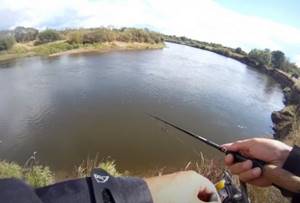
But in fact, it is a typical place for pike. There are two options - casting at an angle to a steep bank, and/or across the current. It is also possible to fan the entire protractor by 180 degrees. In the sunshine (July, early August in mid-latitudes), river pike moves to depth; the higher the pressure, the lower it stays, trying to stay in layers saturated with oxygen. It is worth looking in holes, pits, edges, and in the bends of steep banks. In the pits, more powerful baits and weights are needed; various non-hooking baits are used.
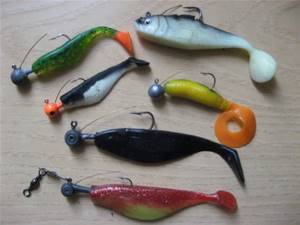
Non-snagging blind mounting with spring

Java stick works on passive pike in the low summer season
Features of jigging for pike in the fall: choosing bait, searching for a predator, retrieving
Autumn can be divided into two periods, each of them has its own characteristics. The first is early autumn (mid-August-mid-September) and the second is late autumn (mid-September and November until freeze-up).
If at the end of summer and beginning of autumn the water is still warm and the habits and resting places of pike are in many ways similar to summer ones, then in late autumn it rolls down to the deepest places of the reservoir - holes, channel and bank edges and entry points into them.
Read more about the habits of pike in late summer and early autumn in our article.
In autumn you often have to fish at great depths in cold water. At this time, it makes sense to use active tires - rippers, shads, twisters with an active play of their own. The colors are acidic, bright, catchy. Red, silver, yellow, green, fluorescent and glitter.
Classic rubber for pike in the fall - Relax Hoof, Relak Aqua, Mance Predator, Mance Assassin, Bass Assassin, Akara pike vibrotails, Pantun 21, Lucky John and others.
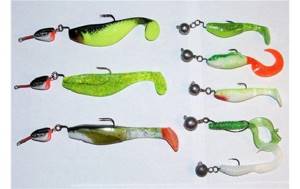
The left row is for pits and edges, the right is good at the entrance to pits, in the bends of steep banks and for oxbow lakes
The maximum size of jig baits for autumn pike is 3-5 inches. The predator fills its belly before the freeze-up. Doesn't want to waste time on trifles. But it is worth considering the size of the expected trophy. If a killo is already a trophy for a particular body of water, then 2-3 inches will be enough.

Mance Predator on the tee
The pike bite on a jig in late autumn is characterized by its sweep and amplitude - a sharp and clear blow that is felt by every nerve. An incomparable feeling.
For autumn fishing, it is worth taking different sizes, shapes and colors of working baits. As well as fittings for various types of non-snacking equipment.
Jig fishing in spring
Spring fishing is somewhat different from summer fishing, since it takes place in relatively shallow places. During this period, the predator is still just recovering its strength after wintering and you should not count on strong activity of the fish. It is for this reason that relatively light tackle can be used in the spring. The thinner the tackle, the greater the number of bites you will be able to realize. And the fact that in the spring the predator goes to shallow spawning grounds can even give a novice the idea that light weights should be used, which will be convenient for fishing.
Recommended reading: How to catch carp on a feeder
When fishing in spring, it is better to use compact baits in combination with light jig heads. In this case, the wiring speed should be minimal. Again, in the spring the predator is just building up its strength, and therefore it is more likely to give up pursuing fast-moving prey.
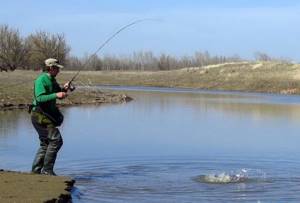
What you need to know about jigging for pike - interesting and informative
It’s not enough to find a pike, it’s not enough to choose a working bait, it needs to be presented correctly. There are several options for animation of jig baits, the rest are variations on the theme.
About jig wiring:
Basic jig wiring:
- Classic step . It can be done either with the tip of a rod or with a reel. In the first case, after the jig has touched the bottom, a sharp lift of the bait is made from the bottom - a pause - the slack of the cord is taken out. And so on in a circle. Often the bite occurs during a pause or at the moment of detonation. The second version of the classic step: the bait touches the bottom, 2-4 quick turns of the reel are made - pause - the cord slack is removed. The rod is more aggressive, the reel is gentle.
- Long step (double/triple/quadruple step). The bait sinks to the bottom - a detonation is made with the rod, the cord is quickly selected and, preventing the bait from falling, another detonation is made, and so on from 2 to 5 times. Then the jig sinks to the bottom and everything repeats. In this case, the bait moves in steps in the water column. You can play with the number and length of steps.
- American . The bait cast falls to the bottom and the slack is picked up. Pulls are made with a spinning rod, but not sharp, as with the classics, but smooth, as if pulling the bait along the bottom or at the very bottom. The retrieve is lazier and is suitable for passive fish and warm water.
- Jumping on the bottom . Small-amplitude and high-frequency jumps at the bottom. Implementation - small continuous jerks with the rod with almost no pauses.
- Wavy . This is done using a coil. The rotation speed varies, which sets the wave-like movement of the bait, but without the jerky component. You can touch the bottom or not.
- Wiring for demolition . Option for current. The cast is made across the stream or slightly higher. The weight of the load is selected so that the bait is dragged along the bottom. At this moment, the cord is unwinded from the angler's side. It turns out that the silicone moves in two projections, actively raising a cloud of turbidity at the bottom. A very good animation option for cold water, passive fish and large water areas.
- Uniform . The most common uniform winding in a given water horizon. Using pauses, you can vary the depth of the bait even on one cast.
- Dragging along the bottom . This type of wiring is used for the most passive fish, when the predator does not respond to other types of animation. Combined with fairly long pauses. Works well on edible passive rubber.
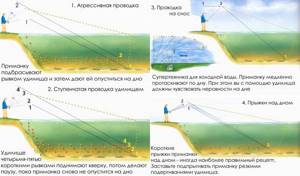
Jig tackle
The first feature of jig fishing concerns gear. It is best to give preference to a spinning rod with a fast or ultra-fast action. It is such a form that will allow you to perform high-quality wiring and respond in time to even the slightest touch of the bait by a predator. As for the rod test, you should focus on the size of the intended trophy, and therefore the weight of the bait. If you are going to catch perch, then a light rod with a weight of 2 to 8 grams is suitable. But if you plan to hunt for pike or pike-perch, you can stop at a form with dough from 10 to 30 grams. The reel for jig tackle also deserves some attention. Although everything here is not as critical as in the case of the fishing rod. The most universal solution can be considered a 2000 class spinning reel with a front friction brake. A reel of this size will allow you to catch almost any predator. When changing the fishing object, you can only replace the spool. After all, cords of various diameters can be wound onto several bobbins. A spool with a thin cord can be used when catching not very large predators, and a thick cord is better suited for catching trophy predatory fish.
We recommend reading: How to tie a jig to a winter fishing rod
Monofilament fishing line is not used in jig fishing. After all, it stretches a lot. Of course, when fishing, this feature even plays into the hands of the fisherman. After all, the fishing line cushions the fish and forgives the beginner the mistakes made during fishing. But with monofilament fishing line it is impossible to make high-quality wiring. The connection with the bait is literally lost. It is for this reason that even a beginner should prefer a braided cord.
The best silicone lures for pike - universal rubber that works
Depending on the season, reservoir, and weather, pike prefers different types of jig baits - the gradation is based on type, size, body shape, activity/passivity, color and other factors. It is not possible to bring all the factors together; this experience has been gained over the years and many factors influence the choice of a particular bait in a particular situation.
There are no absolute dogmas when choosing the “best” silicone bait for pike; there is a subjective choice depending on the conditions, which is based on practical experience of use, as well as some axioms that should be adhered to, but not blindly believed in them:
- In spring and summer, baits are used in smaller sizes than in autumn relative to the same body of water.
- In muddy and deep water, the colors are more poisonous and interspersed with sparkles.
- In clear water, colors imitate food supply.
- Acid colors are like provocateurs to grab hold when nothing else works.
- Autumn is the time of active baits.
- Passive fish - passive baits. Active - active.
- Running rippers are more suitable for the current than shad.
- Always use a comparable weight for the bait. A 20 gram head on a 1-inch silicone fish looks ridiculous.
- Use high-quality soft rubber baits. Which play well even at low wiring speeds.
- The best bait is the one that the spinning angler understands and believes in!
- Experiment.
So, for example, the color of silicone for river pike in the fall implies the use of sparkles in the composition, due to the fact that you often have to fish at great depths, and in overgrown swamps matte colors will be good - muddy with red, dark yellow, machine oil.
Bass Assassin Turbo Shad is a fast-paced ripper in different colors with sparkles, works great in holes of 4-10 meters with appropriate loading depth
TOP 15 universal “tasteless” and edible silicone baits for pike:
- Man's Predator 2-5 inches. Universal working small, medium and large rubber for pike. The size is selected based on fishing conditions. In oxbow lakes along water lilies, 2 and 2.5 inches work all year round. The pearlescent bloom turned out to be especially good. 3-4 inches are good on holes and edges, especially in the fall. For trolling 5.
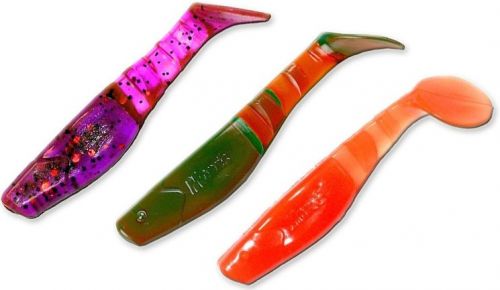
- Mance Assassin (Man's Assassin). Has a more active game compared to the Predator due to the reverse notches on the tail. Often more catchy than its brother.
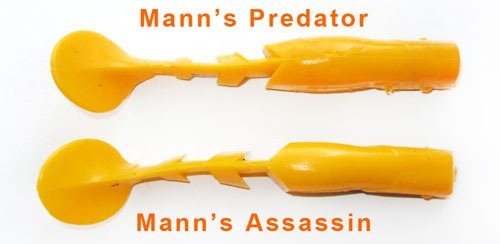
- Relax Kopyto. 2-3 inches. Classic. Small two-inch ones in S002 color mow down pike in oxbow lakes. Larger models along river edges and holes.
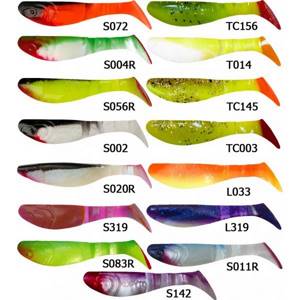
- Relax Aqua. Very decent tires from Relax. Application in holes and pits, slow rifts. Stubborn.
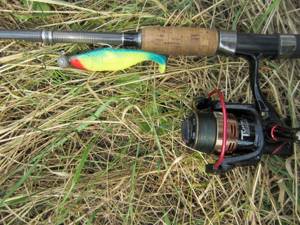
Relak Aqua - Bass Assassin Turbo Shad. Active game, wide range of colors. A massive nickel provides wide-amplitude oscillations. In the pits on a jig or a joint with a bullet is an excellent option.
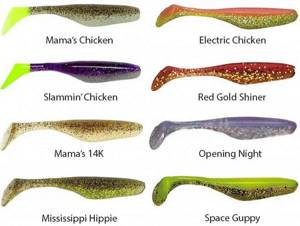
- Pontoon 21 Awaruna. 3.5, 4.5 . Wide range of colors to suit any conditions. Floating initially. It is good to use in rigs that will ensure the position of the bait for the feeding fish - spaced apart, heads such as an iron and a spoon.
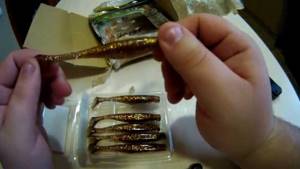
- Lucky John Joco Shaker. Edible silicone vibrotail with a ribbed notch on the body. Works on a wide variety of installations.
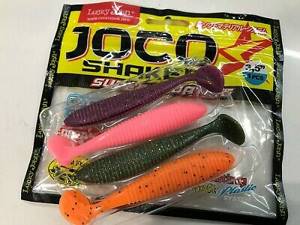
- Lucky John Tioga and Lucky John Tioga Fat. The ribbed notch provides the bait with active play on the slowest retrieve. Works well on uniforms, steps, jumping along the bottom and in the water column. We recommend!
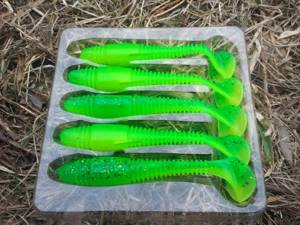
Lucky John Tioga Fat - Lucky John Long John 3.1, 4.2 inches. Driven vibrotails. They performed well in conditions when it was necessary to quickly explore new water areas at various depths. Fan casts on hinged mounting. Mid-frequency vibrations and side swaying.
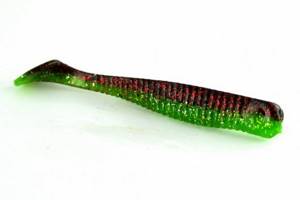
- Sawamura One Up Shad 3-5 inches. Innovative edible vibrotail of unusual shape. There is a tie in the middle of the body, which increases the vibrations of the tail on the wiring. The bait is interesting for its performance on slow retrieval. The fish is constantly in a shaky state, it seems that it is wounded and rushing about. The downside (and the upside) is that the rubber is very soft and loose. The bait literally melts in your hands. And this gives maximum realism in the water, but the bait rarely manages to survive more than 2-3 bites. Installation - jig head, Cheburashka, branch, Carolina and Texas. The bait is floating, so it can be used in rigs - without weight, on a spoon-type head, and with all kinds of leads.

- Jackall Knuckle 3.5. Edible silicone vibrotail from Jakal. The heavy heel provides high-amplitude low-frequency vibrations at the slowest retrieve. What the toothy one loves. The range of colors is not very pleasing, there are no “screaming” ones. But for freshwater conditions, what we have is sufficient. Very durable bait. There is a slot for a more convenient location of the offset hook.
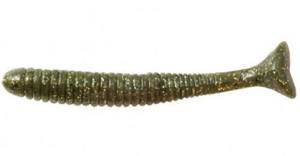
- Keitech Swing Impact and Keitech Swing Impact Fat. The entire model range. Very soft and very edible vibrotails. The first one has a small-amplitude and higher frequency play, the second one, due to the wider body and massive heel, is high-amplitude and low-frequency. The downside is that it is quite expensive.

Keitech Swing Impact Fat. - Reins Curly Curly. 3.3 . Non-standard twister. It is very good in places where there is 20-30 cm of clear water, and then there is grass in which pike stand waiting for their prey. It flies quite well even on a 3-5 gram head. The game is interesting - slow wiring gives small vibrations of the massive tail, faster - spiral wave-like animation.

- Keitech Easy Shiner 3, 3.5 and 4 inches. Edible ripper. Good on spaced rigs and classic jigs. There is a recess for offset. We use it in holes and pits.
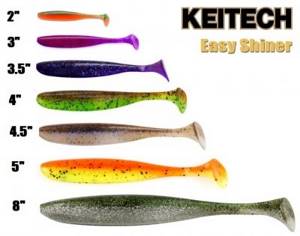
- Imakatsu Javastick 3.4 inches . We recommend using this slug for passive pike; the rubber has shown itself well on rigs such as eyelids, drop-shots, Carolina and classic Cheburashka. A must-have for the beginning “lover”. It’s better to start learning something new with something that works, so as not to be disappointed ahead of time. A bit pricey, but worth it.
It is worth noting that we selected silicone baits with different price tags. From budget Kosadaki and Lucky John, to expensive vibrations from Keitech and Jakal. It seems reasonable to use cheaper models for snags, and expensive ones in proven places and for offset installations.
Equipment
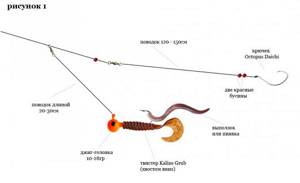
rig with leash
- Direct rig , in which the cord is connected to the jig head, is the most popular. With this option of fastening the tackle, the bait is securely attached to the braided fishing line, which allows you to fish out very large pike perch along with the snags in which they are trying to hide without breaking the bait. But if there is a snag that cannot be eliminated, you have to cut off a significant amount of the cord, which is not very pleasant to do.
- A rig with a leash allows you to break off the jig head along with a small piece of monofilament when a hook is formed. This design is also not without its drawbacks; when fishing for pike perch, sometimes you come across very toothy specimens that can easily grind the monofilament nylon without much difficulty.
Jigs used for pike fishing
Jig equipment is distinguished by a variety of solutions. There are two main ones - a blind rig on a jig head of various types and a rig on a Cheburashka - an eared sinker.
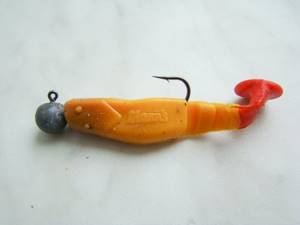
Solid installation
Video on the topic of proper equipment of jig baits on a tee, double, according to the standard on a regular blind jig head and a Cheburashka weight:
Installation of jig heads on pike:

Mounting a ripper on a jig head (clickable)
Option for mounting a silicone bait on a one-sided Cheburashka and an offset hook:
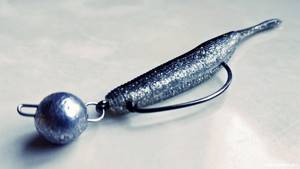
Cheburashka and offset hook
When is it better to use a swivel joint and when to use a blind rig? If you need to use large load weights with relatively small baits (pits, channel edges), then the hinge is a favorite - it gives more freedom to the bait. Otherwise, you can use a jig head as a more compact version of the equipment. Although there are athletes who use only a swivel joint, this is more a matter of taste.
There is also a wide variety of different jig rigs for pike, which are not the topic of this article, and we will go through all of them separately in more detail, but now we will list them with a photo:
- Texas rig.
- Carolina rig.
- Retractable leash.
- Drop shot.
- Wacky.
- Tyrolean stick.
- Jig-rig.
- Unloaded tires.
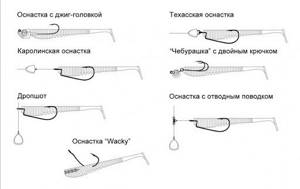
Jig rigs
Jig heads - which option to choose for pike?
There are many options for jig head shapes:

Different types of jig heads are used in different conditions and for different tasks:
- Ski and spoon . When using such baits, the head at the bottom is located at an angle, and with it the bait, which imitates a fish feeding at the bottom. The ski gives a larger angle, the spoon a smaller one. Such heads are good when fishing on shallows and if the bottom is muddy or strewn with small stones.
- Standard ball . Universal and most common form. Used everywhere. The downside is that at the bottom the bait falls on its side. This reduces the attractiveness of silicone and the catchability of fish.
- Rugby . Unlike the standard round head on the bottom always keeps the jig upright. But it is not popular due to the fact that it reduces the compactness of the bait - and this interferes with casting and increases the likelihood of snagging and collecting algae.
- Bullet . Used with driven thin baits - worms, thin rippers, slugs. Good flight characteristics, collects less small algae.
For pike, depending on the manufacturer, we recommend using both jig heads and offset and regular hooks from Decoy and Gamakatsu. It's quality from jig to jig. Sharp, penetrating, holds the bait well. Available in different shapes, weights, with different shank lengths and hook lengths.
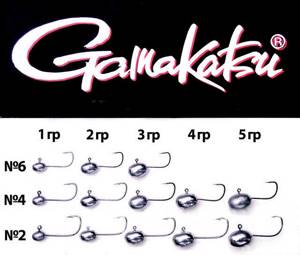
Jamakatsu also has microjig heads
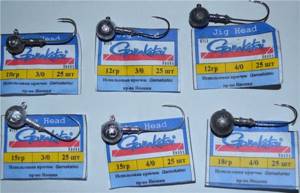
An additional advantage of Japanese Jamakatsu heads, which is especially useful when fishing for pike in strong places, is that their hooks bend when stressed by a break. What does this mean in practice? The fact is that the fish will not be able to break or straighten the hook, but if it catches on a snag with the hook’s point, it can be straightened with sufficiently powerful tackle and the bait can be saved. This process can often be repeated on one head 2-3 times, then it breaks.
The weight of the jig head should be selected based on the fishing depth and the required fishing horizon, as well as the size of the silicone bait. Selected empirically.
Average:
- 1-2 inch bait. 4-6 grams head.
- 2-3 inches. 8-15 grams head
- Over 4 inches. from 15 and above grams head.
From the boat
But when jig fishing using a boat, the angler gets a huge advantage over the fisherman who fishes from the shore. After all, the boat allows you to get to almost any promising area. First of all, we are talking here about the same edges and underwater words. If from the shore it is possible to carry out only wiring perpendicular to the drop, then from the boat it is possible to carry out parallel wiring. In such conditions, the bait remains in the promising zone much longer. But you shouldn’t limit yourself to just this advantage. With the help of a boat, it is easy to reach those areas of the reservoir that experience less pressure from spinners. So if the shore in a certain area of the reservoir is overgrown with dense vegetation, this is where you should swim. In addition, it is advisable to fish holes, underwater hills, banks, remains of artificial structures and other natural, as well as artificial shelters. When searching for such anomalies, an echo sounder will serve the spinning angler excellently. If in the case of coastal fishing the use of an echo sounder seems difficult, then in the case of fishing from a boat, an echo sounder looks very appropriate. After all, it is enough just to fix the echo sounder sensor slightly below the bottom of the boat and the underwater world will open up to the hunter as if in the palm of his hand. After this, all that remains is to place the bait in the desired sector and make the correct retrieve.
Recommended reading: Fishing for cicada lures
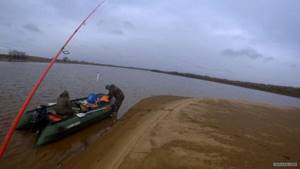
Spinning jig fishing is one of the most versatile ways to catch predatory fish. After all, the same silicone baits can be used in winter. Even with vertical play they will perform great. This means that you definitely shouldn’t neglect learning jig fishing!
What should the tackle be like?
For jig fishing there is a so-called class of jig rods. Such rods have an extra-fast action, they are quite “angry” and sharp, both on a typical “step” and when casting and retrieving a predator. But such prickly rods are more suitable for catching bony pike perch, while for pike it is better to work with a semi-parabolic spinning rod or an intermediate one between fast and semi-parabolic action. This form binds the pike better and does not allow it to spit out the bait on the candle.
An additional bonus of a soft stick is that it is more catchy and allows for long and accurate casting, which is often necessary in jig fishing.
A jig spinning rod must have what is called “ringing” and “feel” in the spinning community. Clearly convey everything that happens to the bait under water - tapping the bottom in your hand, the fisherman must read the terrain, hooks on algae and the most careful bites through tapping on your hand.
So what should you choose? Ideally, have two spinning rods for jig fishing - fast and semi-parabolic, each for different conditions. It is also worth considering that a shore spinning rod in most cases should be longer than for fishing from a boat. In all this, the coil may be the same. But not everyone has the financial opportunity for such luxury and often has to choose one thing.
The test is selected based on several components:
- the weight of the proposed baits;
- weight of expected prey;
- type of reservoir - depth of fishing, strength of current or its absence;
- aggressiveness and type of wiring;
- need for long casting.
The usual all-rounder for small and medium-sized rivers of the Russian Federation and the CIS is usually light and higher according to the test: 3-18, 5-21, 10-30, 10-35 grams. Composite or carbon, depending on the experience of the fisherman and financial capabilities.
If you have to fish in difficult places where forced fishing is necessary, you should add 15-20 percent to the test in order to have a margin for maneuver. These are rivers with numerous snags and stone ridges.
The reel is always matched to the form - balance must be maintained. The quality of the cord laying is also of great importance - otherwise, with jerking wiring, beards, mustaches and overlaps are inevitable. Size 2000-2500 according to Shimano classification. Diameter 0.12-0.15.
Recommended manufacturers: Daiva, Shimano, Spro, Riobi.
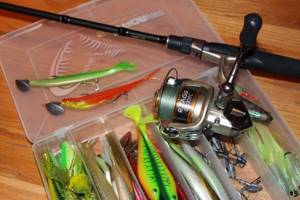
The braid is selected to match the size of the spool so that it lies 120-150 meters short of 1.5-2 mm to the edge.
A leash is required, size 20-30 cm.
Of course, even following all our advice does not guarantee that jig baits will always and everywhere catch pike, but it increases the chances of success. Where a beginner is left without a catch, an experienced fisherman can get away with nothing; where a beginner catches a bucket, an experienced fisherman cannot take his catch from the reservoir.
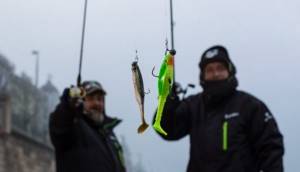
Jig fishing for pike perch
in spring
You can catch pike perch with a jig immediately after the ice melts on reservoirs and right up to freeze-up. In the spring, pike perch is best caught from mid-April to mid-May . The fish gather in schools and begin to eat. The most productive period for catching pike perch is pre-spawning, which lasts 1-1.5 weeks. If you know a place where pike perch are caught, fish for them regularly and you can get to the pre-spawn fish hatch.
When looking for a place to fish for pike perch in the spring, the bottom topography is not so important. Schools of pike perch can feed in different places. It is better to choose the tactic of constantly moving and fishing different areas. After May 10, it is very difficult to catch pike perch. You may mainly come across fish that guard the clutch with eggs and rush to any bait, but this option is not sporty.
Fishing with poppers using a spinning rod. Read about this in our article. Watch the video.
And here you will read about ultralight fishing.
In summer
In summer, pike perch actively feeds mainly only at night . It spends most of the daylight hours resting in deep places. To catch it during the day, the bait must be placed directly under the nose, provoking the instinct of a predator. Its bite at this time is aggressive and unexpected. In the summer, pike perch lives in areas of reservoirs with oxygen-enriched water. For ambush it chooses places in pools, holes and under snags.
The right time for catching pike perch is early morning (from 4 to 8 o'clock), during sunset and a few hours after sunset, when the largest pike perch bite. After about 8 o'clock in the morning, the pike perch stops actively feeding, but instinctively hits the bait with the tip of the gill cover. At this time, most bites are empty, sometimes the fish grabs the lower part of the jaw.
Usually at night, pike perch are caught using classic baits . Jigs work better at sunset; at nightfall, wobblers are preferable. In addition to the usual twisters and vibrotails, various foam rubbers are used as jig baits in summer night fishing. Less often - wabiki made of fur and Christmas tree rain.
Posting an oscillating spinner. Read about this in our article.
And here you will learn about the technique of casting a spinning rod.
On the site you will find a lot of other interesting information about fishing.
in autumn
From the end of August you can already catch pike perch with a jig. As the weather gets colder in early October, zander begins to eat again . It lasts until mid-November. At the same time, the fish begin to gradually move to wintering places at greater depths. This period is favorable for jig fishing.
Autumn fishing is more successful from a boat, as you can fish in deep areas that are not easy to reach from the shore. The best places for pike perch are near holes and whirlpools with a depth of at least 4 meters. At the end of November, the bite subsides, but a week before freeze-up you can catch quite large specimens.
Jig fishing is quite simple and productive. Mastering basic jig fishing techniques is not difficult. Thanks to the ability to place the bait at the very bottom, the spinner has a high chance of success. It is better to start mastering jig spinning in the still water of a reservoir in order to learn how to determine the position of the bait by the sag of the fishing line.
The main factors influencing the effectiveness of the method are the sensitivity and harmony of the elements of the gear, the possibility of maximum control over the bait. With proper equipment, correct wiring and knowledge of the vital functions of pike perch, jig fishing will always give a good result.
Spring jig
There are year-round baits, and there are seasonal ones. Jig, for example, basically works throughout the year. But the rotating spoon is used for fishing primarily in the summer. Summer is here - everything is ahead. Therefore, it’s time to remember the “turntables”. Today we will do this in relation to small rivers. Stubbornness or narrow specialization? Nowadays everyone, or almost everyone, for whom the spinning rod is not limited to a St. Petersburg aluminum “stick”, a “Nevskaya” reel and a “Klin” fishing line, catches on “spinners”. Another thing is that some turn to “turntables” occasionally, while others, on the contrary, extremely rarely go beyond this class of bait. In the fixation on rotating lures, one can see both a banal desire to take the easiest path (after all, “spinners” are easier to learn than other types of spinner baits), and a healthy, in general, desire to master the technique of fishing with “spinners” to the maximum extent . Among my friends there are several people who belong precisely to this second category. Therefore, I would immediately like to note that I understand the topic of hunting with a “spinner”, probably not as deeply as these narrow specialists. Nevertheless, I will allow you to share my observations and thoughts on this matter, but at the same time, leaving many questions open - perhaps one of our readers will find it appropriate to outline their approach to fishing with rotating spoons on small rivers. What should be in the box Let's first say a few words about the set of spinners that we should take with us - on the assumption that these will be “spinners” and nothing else. The best thing to do here is to follow the rule of a reasonable minimum. When I go to a small river for the whole day in the summer, I rarely take more than a dozen spinners with me. If the river is well known, then it is known in advance which fish (type and size) should be mainly counted on, therefore both the models and the sizes of the spinners are selected quite specifically. For example, you know that in your river the main predatory fish is pike, weighing an average of one kilogram, and in addition there is a chub, weighing an average of four hundred grams. Accordingly, when completing the box, we put spoons of numbers two through four there. Smaller or larger ones, if required, will be in rare cases. For example, if it doesn’t work out with a pike and a full-fledged chub, you can set it to “zero” and grab smaller chubs. But is it necessary? This is what you should take as responsibly as possible, this is the selection of spinner models. If in a standstill a “Comet” or a basic “Blue Fox” may be enough for almost all cases, then on the river you need to have at least three fundamentally different types of “spinners”, and the difference here is determined by the optimal direction of wiring for each specific spinner in relation to flow. For upstream fishing, you can take, for example, the classic Rooster Tail and especially the Mosca Graffy. Wiring in the transverse direction - there is more choice here; I myself often use the DAM “long”, “Mosca Rastel” or “Double Loon”. The most difficult option is to choose a spoon for fishing downstream. Sometimes the usual “Aglia” is enough here, but quite often there is a need for emphatically lightweight “spinners”... Subtleties of “Upstream” ... The fishing method, when extremely light “spinners” can be of great benefit, is usually called “upstream”. This term, which comes from the English “up stream,” may very well be familiar to you, since it is often used in fishing literature. Initially it concerned trout and salmon fishing, but now it is used more widely. The main prerequisite for “upstream” is the characteristic position of the fish standing in the current. It doesn’t matter whether it’s a predator in ambush or some abstract fish on vacation, but the position is almost always the same - head against the current. The viewing angle of the fish is about 300°, and behind it there is a dead zone, from which you can approach unnoticed with a greater guarantee. I knew about this for a long time, but somehow I didn’t really believe that this principle actually worked. Faith came after a single fishing trip that took place seven years ago. At first I tried to catch the chub by moving downstream. It was easy and convenient - that is, it was easy to move forward, but not to catch... Then I decided to turn around and, although I was moving along the same area that I had passed through quite recently, and I had to move the lure faster than I would like, I began to drag chubs one after another! The psychological threshold was overcome, and since then, when I get the chance to fish with a “spinner” on a small river, I try to stick to the “upstream” method. The method has two main varieties - fishing from the shore and wading. The coastal option is somehow simpler. You move along the river, throwing a spoon in front of you. I often use this fishing method in combination with jig fishing: when I go downstream, I fish holes with a jig, and when I go back up, I cast a “spinner” over areas with medium depths. But problems often arise here - due to the fact that not everywhere the banks are easily passable. More precisely, at the beginning of summer it is still possible to somehow walk along the shore, but by July the nettle-wormwood jungle makes this almost impossible. And then there is nothing left to do but move through the water. What equipment is required for this depends on the specific river - the water level, depth, etc. Sometimes you can get by with waders, but more often you still need waders. However, when it’s warm, you can undress and fish in beach and swimwear. But it doesn’t hurt to have something like sandals on your feet - there can be sharp pebbles at the bottom, and not just pebbles. Fishing using the “upstream” method with moving through the water is not fast. Usually you walk about a kilometer in an hour. There's definitely no need to rush here. At first, it can be difficult to get used to the idea that you can get very close to fish using this method. But this is indeed true. Even brook trout, such a standard of caution, can be approached within seven to eight meters. At least, I remember several cases when the casting range, due to cramped conditions, was noticeably less than ten meters, but the trout (wild, by the way, and not from a nursery) resolutely took the bait. And there’s no need to talk about pike. Special “upstream” spinners Let’s now return to the question that was outlined just above: what should a spinner be for “upstream”? It is clear that taking into account the wiring along the current, it should be easy. How easy it is - there are options here. It is worth keeping in mind, for example, those “turntables” that in their original form do not have a load - neither on the axle nor in the front. Or, among the Rooster Tail spinners there is such an interesting “Lite” series, in which instead of a weight, a cylinder of foamed plastic sits on the axis. The main purpose of such “spinners” is fishing in “toads” with a minimum fishing speed in the uppermost layer of water. But in our case, they are also useful, since for the normal rotation of the petal of such a spoon, it is enough to move it only a little faster than the movement of the water flow. But still, most often when fishing using the “upstream” method, I use “spinners” built according to the usual design, only with a relatively lighter axial load. For example, I remove the standard weight from the spinner of number four, and instead put the axial weight from a similar “spinner” of number two. Well, or something else in the same spirit. I always have a couple of these “semi-lightweight” spinners in my box with “spinners”. And if I plan to devote the whole day to “upstream”, then to the two “duty” spinners of this type I will definitely add at least as many more. The “wrong” method “Upstream” is effective in most cases. Even, I would say, fashionable and prestigious. You can splurge by throwing it somewhere in a fisherman's shop, not to mention all sorts of squinting..." But there are situations when this method is difficult to apply purely physically, and above all - on rivers with very strong currents. In such conditions, even the lightest spinners with the easiest possible rotation, if driven down the river, require ultra-fast retrieve. A strong current puts “upstream” on the brink of expediency, and sometimes even beyond the bounds. And then you have to give it up. It so happened that I encountered such conditions in the Caucasus (there are simply no mountain rivers in the middle zone), and soon in Italy. Here and there two fish were caught - chub and brook trout. And a little later, when I had the opportunity to take part in the trout championship, the relevant experience came in handy. The essence of the fishing method in such conditions is as follows. A mountain river flows in front of you. More precisely, it doesn’t flow, but rushes down with a roar. In places, of course, there are lulls, and they are definitely worth paying attention to, but most of the river is a “pipe” with a furious current along almost its entire profile, only it is quieter under the banks. From each point, it makes sense to make two or three casts purely downwards, with wiring along your bank, and three or four - under the opposite bank. True, when casting under the opposite bank, the effective part of the wiring is literally two or three meters, then the “spinner” falls into the stream and washes up to our shore. Along it, in the final phase of the retrieve, it also sometimes takes, but less often, since the fish standing in this place has already managed to express its attitude towards the spoon on the first casts. Next, we move, it doesn’t matter so much, up or down, and repeat the same sequence of casts. The fact that during this kind of fishing the fish looks mainly at the angler is not so critical - after all, the strong current masks us. Sometimes it is also useful to modify spinners for such fishing - the same as for “upstream”, only exactly the opposite: changing the axial weight to a heavier one. Back and forth I would venture to guess that most of those reading these lines do not fish in those areas where fast rivers flow from the mountains. Therefore, speaking about fishing with a “spinner”, let’s turn to one of those types of rivers that are typical for inhabited lowland areas. Imagine this picture. There is a large navigable river - with dams and locks, that is, the river is regulated. And there are tributaries of this river. In the pre-estuary sections of these tributaries (about one or two kilometers long), the influence of the main river is felt, namely: the backwater of water changes greatly from time to time due to the operation of the locks. This is how it manifests itself. You are fishing on a small river and suddenly notice that the current in it has either noticeably increased, or, conversely, has almost stopped, or even gone in the opposite direction. The closer to the mouth, the more pronounced this is. I could explicitly name several such rivers flowing into the Moscow River and Oka, but I won’t make the task any easier for you. It’s better to figure out for yourself which ones we’re talking about if you’re interested. As a hint: the reverse flow effect is strongest on those rivers that flow into the main river below the hydraulic structures located on it and as close as possible to them. Now the time has come to answer the question: what interest can we actually have in all this? Everything here is extremely simple: fish in such sections of rivers (and pike in the first place) bite, first of all, in those short intervals of time when the current differs from its standard. And, again, from experience, the majority of bites in such cases happen on a rotating spoon. The difference from the standard is often an acceleration of the flow, less often a change in its direction to the opposite. Despite the fact that these phenomena take up only ten percent of the total fishing time in the pre-estuary section of the river, they account for about three-quarters of all bites. And if you notice that something has happened over time, try to use this time effectively. Don't be distracted by smoking breaks and alternating baits. Place a “spinner” of a universal plan - for example, “Long” of the second or third number, and get the result. Forecast for the near future I am writing these lines a week before the start of calendar summer and I have certain reasons to make a forecast regarding the timing of when this year the predator (primarily pike, secondly perch) will begin to consistently “eat” on small rivers rotating spoons. Here, much is determined by the weather in the last spring month. This May turned out to be generally colder than the climate norm in our central zone. It is characteristic that today I was on a small river, and the pike did not bite on anything other than a jig. Based on the experience of previous years with a cool May, a change in the behavior pattern of pike, after which it will be well caught on a “spinner” (and at the same time on active wobblers), will occur in the second half of June. So fans of spinners will have to wait a little longer this year. Based on materials from the Russian Hunting Newspaper Author K. Kuzmin
How to fish with a jig from the shore in the pits
Almost every river has the deepest sections - holes. It happens that you can even reach them from the shore. We were lucky - this is the first area where we need to start fishing. But you need to approach pit fishing creatively, remembering the basic rules:
1. In the pit itself, the predator, as a rule, only defends itself and is not too active. However, if the playing bait passes right under his nose, the predator may attack it.
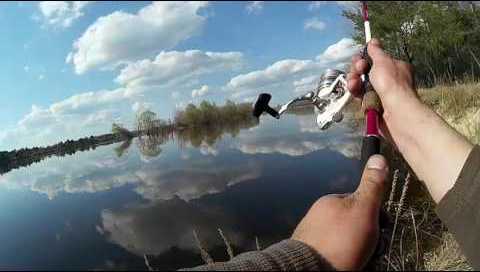
2. Particularly large catfish, pike and pike perch can stand and hunt in the hole itself, if there is shelter there: snags, underwater hills, etc. But in most cases, predatory fish raid nearby small areas: riffles, shallows, bays, etc. During the hunt, the predator is hungry and actively takes almost any suitable bait.
3. As a rule, the predator has its own route to feeding and back, which includes going around the most “feeding” places. In this case, the hunt will be successful if you sneak up on the prey unnoticed: from behind, from the depths, against the sun, etc. From here it is clear that a predator can, leaving a hole, ply “under the edge”, camouflaging itself in its shadow - this makes it easier to sneak up on a potential victim without being noticed. This means that the predator will probably prefer the edge of the pit where the edge is steeper and provides more shade. Although the edge is an edge, this factor is not necessary. The main thing, of course, is different - the predator goes to those places where small things “graze” (rifts, shallows, bay, etc.). And even if the path is open and inconvenient, the predator will still go exactly there - towards potential prey: either bypassing, camouflaging; either directly, by throwing or “driving”.
4. In order for the prey to be clearly visible, and the hunter himself to be in the “blind” zone, he will try to use light: the sun should be behind and well illuminate the hunting area. Perhaps the difference in time with which the predator visits different areas is related precisely to their illumination? In any case, try to cast more “into the sun” or away from it, because It is always easier for a predator to detect and pursue prey, on the contrary, from the sun.
From Fig. 2 it is clear that the left slope of the hole is more convenient for hunting, because is best lit, and the predator attacks from the depths and away from the sun, where it has a better chance of remaining undetected. On the right, on the contrary, the predator looks “at the sun” and sees the prey worse, but it sees the hunter perfectly.
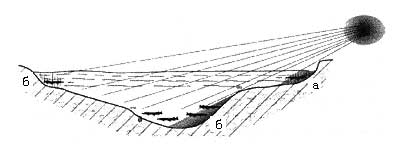
Fig.2. The position of the predator relative to the sun: a) advantageous; b) unprofitable.
From the same figure it can be seen that the predator standing in the bank grass on the right has a better position than the one standing on the left, because he himself “camouflages” in the shade of algae, and sunlight does not interfere, but helps him in observing his surroundings.
The influence of sunlight should not be overestimated; it is noticeable in clear skies, bright sunshine, at shallow depths and in calm, windless weather. In other cases (wind, clouds, depth, etc.) the influence of the sun is significantly reduced.
5. A predator has a better chance of remaining unnoticed if it sneaks up on its prey from behind, and since the small fish mainly stands with its head against the current, the predator should attack from behind, also against the current.
According to these rules, your catches will be maximum if you:
- Fish the hole from the side that borders the predator’s feeding area: a riffle, a shallow, a bay, etc.
- Choose a place where the cast is made against the sun, and the bait is placed a little upstream from the predator’s ambush.
- Remember the time of the best bite. There is a high probability that at this time the predator has optimal lighting conditions underwater, so next time it will go hunting at the same (or close) time.
In most cases, the hole in the current has an uneven depth (Fig. 3). The upstream slope is steep, since its edge is covered with bottom sediments, and a zone of eddies is formed under it, which washes out the hole (like behind a stone). The side slopes of the pit are less steep, and the back slope is the smoothest and most gentle. Therefore, if there is no shelter in the pit itself (snags, driftwood, etc.), then the fish, and therefore the predator, will stay mainly under the front slope, much less often on the side slopes and very rarely on the back slope.
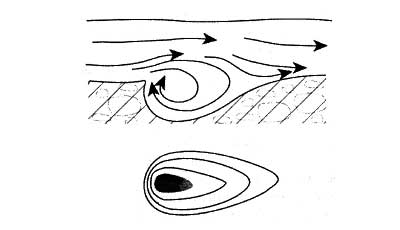
Fig.3. Distribution of depths in the pit.
Where are the holes found? There are several obvious options, although it should be remembered that there are “non-standard” holes that are difficult to predict, but can only be discovered and remembered.
We already know that before and after the roll (and other narrowings) there is an entrance and exit hole. Another common case is a hole at a sharp turn in the river, where a stream hits the opposite bank, washing out a deep pool underneath, which all fish love very much. The main landmark is a steep bank. The steeper it is, the greater the depth of this shore, the greater the likelihood of a deep hole. It can also be “predicted” by the surface of the water: if the flow is uneven, there are turbulences, whirlpools, “return” - these are also signs of a hole.
Another case is a hole behind the outgoing stream, where a reverse current is formed, washing out the hole itself and the trace behind it, and also “pushing” the main stream away from the shore. But not every outgoing stream must have a hole behind it. This usually occurs with a “soft” bottom, but if the bottom is hard (rocky, pebbly, sandy), then, on the contrary, there will be a sandbank behind the stream.
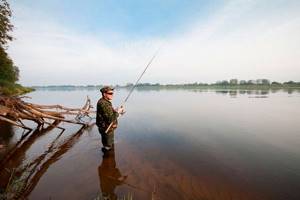
How to fish in a hole? The fact is that this fishing has its own characteristics. In the pit itself, the predator is resting and, in order to provoke it to grab, you need to hit it “on the nose”, and even imitate a greatly weakened prey. Hence the conclusion: a promising hole must be carefully “combed” in different directions, and the bait must be large enough (the mouth is happy with a large piece, and the predator is the largest in the hole) and the easiest to play in order to carry out a slow step-by-step retrieve. Large twisters, vibrotails and octopuses are especially suitable. When the fish is slowed down, “sluggish” passive baits can help out: “big worm”, “squid”, foam fish.
The best colors in the deep hole are light and “illuminating” ones: glow, fluorescent yellow, lemon, milky white and yellow, as well as bright “acid” colors – green and red. The head weight should be as light as possible (the lightest among the heaviest) so that the bait falls more slowly, but at the same time the necessary contact with it remains. “Standing” heads are good: “boot”, “horseshoe”, etc., which can be carried out with stops, allowing them to stand on the bottom for some time. The current in the pit is complex, vortex, weak at the very bottom, and since the depth is decent, the line can bend noticeably. This means that it should be as thin as possible - wicker is best. But more often, bites occur not in the pit itself, but in the area of the edge, where the predator goes hunting. It is along the dumps that the main fishing is done. There are two options here: fishing along the edges of the pit and fishing through the pit (Fig. 4).
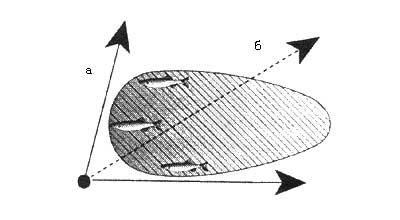
Fig.4. Fishing of the pit: a) along the edges; b) through the hole.
Fishing along the edges is the simplest and most effective. Since the predator is “on duty” under the dump, we try to move the bait above the dump, if possible along it. It is clear that this tactic is the most effective, although, unfortunately, it is not always possible, especially from the shore. Therefore, you often have to fish through a hole.
In this case, the cast is made into the pit itself or through it, where possible. A situation often occurs here (Fig. 5a), when our bait approaches a nearby drop from the depths and “sticks” into it. At the same time, it no longer works, but furrows the bottom, often gets caught and scares away the fish. There are almost no bites in such cases.
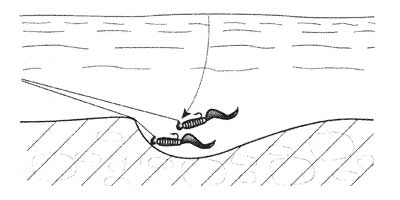
Fig.5. Transition of the bait over the edge: a) with grazing; 6) without touching.
Here it is advisable to roughly imagine the upper edge and try to cross it, like an airplane flying over a mountain. The easiest way: cast a little further, lower the bait to the desired depth (counting to yourself) and pass it over the drop with a uniform or wavy line - usually this is enough for pike. If the edge catches, then you should start winding even earlier (count). And if you manage to place the bait exactly on the upper edge and make a “step” 5-10 m, then it will be irresistible for pike perch, perch, and pike too.
But here, in the wiring above the dump there is a “colored” nuance, because the predator sees the silhouette of our bait from below, against the background of the light sky and water surface. Therefore, especially in the sun and ripples, when everything is glare and colorful, a light bait can “get lost” in this shiny space. Look at the sky when small clouds are rushing across it and the sun is shining brightly - which plane will you see faster, light or dark? So here, the winning bait will be dark in color (black, brown, red) and larger in size.
If we are fishing through a hole, then on approaching the near edge the bait must be lifted by quickly rotating the reel and rod and passed over the upper edge without touching.
In any case, it is useful to make a few light jerks in the working area to attract attention to the “prey” and imitate a weakened fish - simple prey for a predator. Having passed the edge and the control 10 m behind it, you can simply pull out the bait - bites far from the dump are quite rare.
